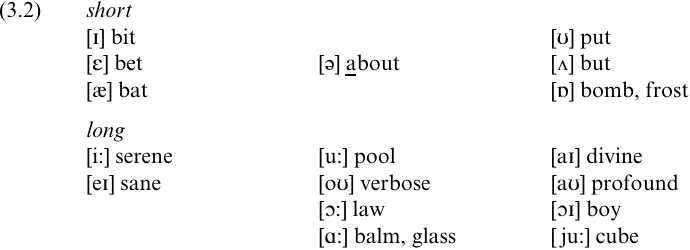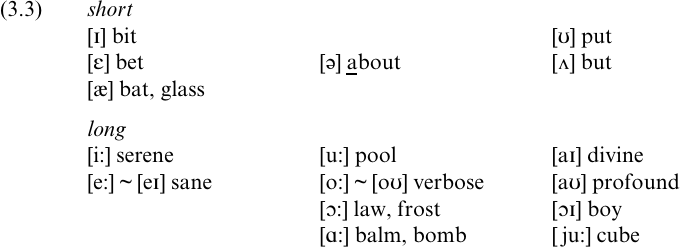

Grammar


Tenses


Present

Present Simple

Present Continuous

Present Perfect

Present Perfect Continuous


Past

Past Simple

Past Continuous

Past Perfect

Past Perfect Continuous


Future

Future Simple

Future Continuous

Future Perfect

Future Perfect Continuous


Parts Of Speech


Nouns

Countable and uncountable nouns

Verbal nouns

Singular and Plural nouns

Proper nouns

Nouns gender

Nouns definition

Concrete nouns

Abstract nouns

Common nouns

Collective nouns

Definition Of Nouns

Animate and Inanimate nouns

Nouns


Verbs

Stative and dynamic verbs

Finite and nonfinite verbs

To be verbs

Transitive and intransitive verbs

Auxiliary verbs

Modal verbs

Regular and irregular verbs

Action verbs

Verbs


Adverbs

Relative adverbs

Interrogative adverbs

Adverbs of time

Adverbs of place

Adverbs of reason

Adverbs of quantity

Adverbs of manner

Adverbs of frequency

Adverbs of affirmation

Adverbs


Adjectives

Quantitative adjective

Proper adjective

Possessive adjective

Numeral adjective

Interrogative adjective

Distributive adjective

Descriptive adjective

Demonstrative adjective


Pronouns

Subject pronoun

Relative pronoun

Reflexive pronoun

Reciprocal pronoun

Possessive pronoun

Personal pronoun

Interrogative pronoun

Indefinite pronoun

Emphatic pronoun

Distributive pronoun

Demonstrative pronoun

Pronouns


Pre Position


Preposition by function

Time preposition

Reason preposition

Possession preposition

Place preposition

Phrases preposition

Origin preposition

Measure preposition

Direction preposition

Contrast preposition

Agent preposition


Preposition by construction

Simple preposition

Phrase preposition

Double preposition

Compound preposition

prepositions


Conjunctions

Subordinating conjunction

Correlative conjunction

Coordinating conjunction

Conjunctive adverbs

conjunctions


Interjections

Express calling interjection

Phrases

Sentences


Grammar Rules

Passive and Active

Preference

Requests and offers

wishes

Be used to

Some and any

Could have done

Describing people

Giving advices

Possession

Comparative and superlative

Giving Reason

Making Suggestions

Apologizing

Forming questions

Since and for

Directions

Obligation

Adverbials

invitation

Articles

Imaginary condition

Zero conditional

First conditional

Second conditional

Third conditional

Reported speech

Demonstratives

Determiners


Linguistics

Phonetics

Phonology

Linguistics fields

Syntax

Morphology

Semantics

pragmatics

History

Writing

Grammar

Phonetics and Phonology

Semiotics


Reading Comprehension

Elementary

Intermediate

Advanced


Teaching Methods

Teaching Strategies

Assessment
Applying the constraints: the Modern English Vowel Shift Rule
المؤلف:
APRIL McMAHON
المصدر:
LEXICAL PHONOLOGY AND THE HISTORY OF ENGLISH
الجزء والصفحة:
86-3
2024-12-02
1334
Applying the constraints: the
Modern English Vowel Shift Rule
Introduction
Introduction
We attempted to strengthen the constraints usually assumed in Lexical Phonology, and to streamline the architecture of the lexical component, reducing it to two levels. However, these alterations were mainly made on general theoretical grounds, and were largely independent of actual phonological analyses, then, we turn to the application of the constraints. Specifically, I shall propose a revised account of the Modern English Vowel Shift Rule (VSR), which adheres to the principles that underlying and lexical representations should be identical in non-alternating and underived forms. This reanalysis will have implications for various other aspects of the English vowel phonology, including the analysis of surface diphthongs, and the derivation of the [jū] sequence, and will furthermore indicate that synchronic rules can differ markedly from the historical changes which originally caused the variation they describe, a hypothesis to be developed later. Finally, even given the constraints of LP, dubious cases will inevitably arise. For instance, alternations may exist in a language, but the time depth from the creation of these alternating forms may be so great, and the forms involved so few, that speakers may be unable to discern a synchronically productive pattern. The adoption of a more concrete phonology may enforce a division between those alternations which are derivable by rule from a common underlier and those which are better treated as stored variants, and I shall show below that a less abstract formulation of VSR clarifies the difficult area of supposed `regularity' for Modern English verbs.
Before turning to VSR, we revisit the vowel system of Halle and Mohanan (1985), which shows the main problems that a revised account of English vowel phonology must confront (see (3.1)).

Halle and Mohanan are primarily concerned with General American, but claim their underlying vowel system is also appropriate for RP; this assignment of a single underlying phonological system to related dialects was a characteristic of SGP which Halle and Mohanan carry over into LP, and which we shall challenge below. As a result of this assumption, Halle and Mohanan propose a single underlying representation for the vowel in balm, and one for bomb, despite considerable surface variation. Absolute neutralization means that [jū] in cube and [jū] in venue are derived from distinct underlying vowels, while all underlyingly tense vowels take a free ride through VSR. The revision of Vowel Shift below will address all these issues, directly or indirectly.
Note first, however, that the terms `RP' and `General American' are both to some extent controversial. Gimson (1973: 116) describes RP as `a somewhat fictional standard [that] has been in existence for centuries and was finally sanctified some forty years ago by the BBC's Advisory Committee on Spoken English'. This is of some concern to Ramsaran (1990: 180-1), who comments that `Since RP is the only accent that I have ever spoken with, I have a subjective conviction that it exists. This is, of course, an indefensibly circular statement. More objectively, I could say that I discovered as an undergraduate that my native accent was fairly accurately described in Gimson (1962).' In a sense, both Gimson and Ramsaran are right. Ohala's (1974) assumption that individual speakers may have different underlying representations, for instance, will render `somewhat fictional' any system not based on detailed observation of the usage of a single speaker. Yet to make our conclusions interesting and significant, we surely have to extrapolate beyond this detailed level. The fictionality of RP is also assured if we regard it as fixed; the truth is that RP is changing like any other variety, with more conservative versions having, for instance, [ɐ]in blood and guts while more innovative ones have [Λ], and increasing glottalization of stops among younger speakers contributing to the creation of a continuum with London English. With these caveats in mind, phonologists, phoneticians and sociolinguists still see RP as a useful idealization: Nolan and Kerswill (1990: 316), for instance, define it as `the prestige accent of South East England which also serves as a prestige norm in varying degrees elsewhere in England.' I assume for RP the surface vowel system in (3.2) (excluding for the present vowels before historical /r/, which will be discussed later), although I shall from time to time refer to other variants.

Similarly, I use `General American' (GenAm) to refer to a variety with the surface vowel system in (3.3), again with some regional variants which will be discussed below. For the low vowels at least, the system in (3.3) is identical with that of Upstate New York/ Eastern Pennsylvania/ South Midland described by Kurath and McDavid (1961: 7).

 الاكثر قراءة في Phonology
الاكثر قراءة في Phonology
 اخر الاخبار
اخر الاخبار
اخبار العتبة العباسية المقدسة

الآخبار الصحية















 قسم الشؤون الفكرية يصدر كتاباً يوثق تاريخ السدانة في العتبة العباسية المقدسة
قسم الشؤون الفكرية يصدر كتاباً يوثق تاريخ السدانة في العتبة العباسية المقدسة "المهمة".. إصدار قصصي يوثّق القصص الفائزة في مسابقة فتوى الدفاع المقدسة للقصة القصيرة
"المهمة".. إصدار قصصي يوثّق القصص الفائزة في مسابقة فتوى الدفاع المقدسة للقصة القصيرة (نوافذ).. إصدار أدبي يوثق القصص الفائزة في مسابقة الإمام العسكري (عليه السلام)
(نوافذ).. إصدار أدبي يوثق القصص الفائزة في مسابقة الإمام العسكري (عليه السلام)


















